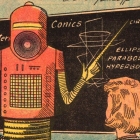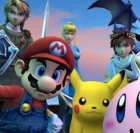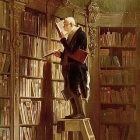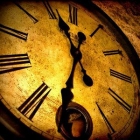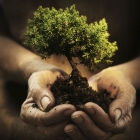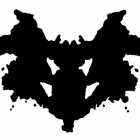Post Overview
-
Text Post
3 years ago+1 1 0Theory of tonal 2
Theory of tonal 2 The discovery and application of conditional color and tonal rule in the West began about the Renaissance in the 15th century. Later, it gradually became more and more popular, so that they formed their traditional observation methods. This is not only reflected in their oil paintings and children's paintings; In poetry and in fiction as well. For example, Turgenev's "The Hunter's Diary" describes the scene of sunset: "The depths of the forest grew dark. The blood-red mist gradually crept up to the roots, to the tree, and ever higher, and from lower to the motionless, sleeping tops. Here the author paints a picture of a warm forest sunset. The above description of dusk tones is reminiscent of Russian painter Kuinzhi's oil painting "Evening in Ukraine," which depicts a mountain village at sunset. The dense mountains were covered with a rosy sunset, in a warm red note. The wall of the hut in the middle was lighted in light rose, and the projection of the branches was painted in light cold green. But people feel that it is white wall. It IS THE WHITE WALL BELOW ILLUMINANT COLOR AND ENVIRONMENTAL COLOR INFLUENCE, IT IS THE WHITE WALL BELOW DUSK ILLUMINATION. It is the white wall when the red afterglow and turquoise sky light come together under these conditions. Like a magician, the painter turns red and green into white in the eyes of the audience. In this way, the beauty of color, which exists in nature and is often ignored, is displayed in front of the audience. Because of the inspiration of the tone in the painter's works, the learner's eyes are opened to observe the tone. However, the nature, life of the image of the tone is kaleidoscopic and extremely vivid natural. There's nothing like it." Nature is better than the ancients." But THESE vivid, rich MATERIAL IMAGE IS Tonal, HOWEVER more IS NOT concentrated, unified, TYPICAL. In two or more than two kinds of color coexistence, also is no main no secondary, disputes and confusion, must be comprehensively summarized by the artist, refining selection, centralized unity. When two or more tones coexist, distinguish the main tone and auxiliary tone. In the life, the nature tone is often not unified phenomenon is in terms of all its images. And from a certain Angle, a certain moment, a certain light conditions, and can find the color of the general unity of the image. Because there are more unified and less unified tonal comparison and existence, people just discovered tonal, tonal unity of the united beauty. The bright side of the east and west scenery is bathed in warm yellow sunlight, that is, unified in the warm yellow tone. After sunset, the earth is shrouded in a cool gray tone. In the bright moonlight, the object looks like the luminous surface, unified in the pale cool green hue. The room below yellow lamplight is unified by the smooth surface in the warm orange hue. Because the natural light source environment is very complex. Therefore, the unity of color tones of natural images is not like the unity of images under color filters, nor is it the unity of colors of artificial light sources on the stage. The image under the color filter, whether the polished, backlit or reflective surface, is stained with a layer of color filter. Tonal although unified, but drab, lost the authenticity of nature. The artificial color on the stage is too pure, and the color image tends to be too "fresh" and "hot". It is strong on stage and suitable for concentrating the attention of the audience. But in the oil painting, it is angry and artificial. The unity of hue under natural light is the unity of contradiction under multiple light sources. Both rich and harmonious, both vivid and implicit. After the artist's concentrated generalization, refining and selection, so that the color in the painting, both like nature, and higher than nature. As the saying goes, "mountains and rivers are picturesque". From the tone, is that the natural landscape is not as clear, concentrated, unified and typical as the landscape in the painting. Painting like the mountains, more than the mountains. Color refining choice, not subjective fabrication. Correct refining and selection, must be able to convey the spirit of the image tone. This should be accurate, vivid, vivid and natural. Tone is not allowed, the morning into dusk, distortion. Lost the painting object of specificity, particularity. Not bright, although has the characteristic BUT not outstanding, the picture effect is "warm "" weak", plausible, ambiguous. Not vivid, stay, die, lack of vitality. If it's not natural, it's artificial. Do these four points, can pass object color god. There are two difficulties in mastering and using tone: First, fix the tone. Tonal should command the whole situation already, tonal decide proper and improper, inevitable influence the whole situation. The tone should be set before the pen. Is it warm or cold? Is it light or dark? Is it yellow or green? Be sure of yourself before painting. Especially difficult in the cold and warm, light and shade control. The mastery of discretion comes from observation, sketching and memory. Be LIKE THE SKY OF OVERCAST DAY, SUNSHINE, THE LIGHT OF NOON SUNSHINE AND FLUORESCENT LAMP, 3 ARE WHITE LIGHT COMPLETELY, AND 3 CANNOT APPEAR AT THE SAME TIME AGAIN. Difficult to compare at the same time, can only be compared in memory. It would have to be based on a lot of sketching observations. Second, the unity of tone. When two or more hues appear at the same time, each hue itself must be unified. Namely the each local color in SAME tonal must be unified in this one fundamental key. For example, "Luen Cathedral" bright details of the color is very rich and varied, but it does not spend. Moreover, from a distance, it only seems to be the substance of the church rather than the accumulation of color blocks. If we are blinded by the richness of the details and forget the unity of the overall tone, we will lose both the tone and the color, leaving only colorful pigments. More IMPORTANT IS BETWEEN A FEW TONAL ALSO SHOULD HAVE ADVOCATE HAVE SECOND, HARMONIOUS UNITY IN WHOLE TONAL. For example, the picture of "Luen Cathedral", the total tone is composed of three colors: one is the warm yellow tone of the bright side of the church. The second is the cold retroactive composition of the orchid and the dark side of the church under the influence of great light. Third, the part of the church lintel facing down is affected by the warm color of the ground, forming a warm tone in the cold. Between them we have the tonic (church light) and the auxiliary two and three. The main tone determines the overall tone and auxiliary tone contrast and foil, mutual influence and mutual penetration. You have me, I have you. Already local subtle change is unified again in WHOLE tonal. Tonal is objective existence, has its own change rule, is scientific. Although science is not equal to art, art can use science however, use tonal law. Do not admit the regularity of tone can not master it, control it, for my use. Of course, only stay in the scientific, regular research will never enter the door of art. Law is not dogma. If you only know the law of cold shadows in sunny days and sunshine, without asking the environment, time and conditions, the shadows will be painted blue when they encounter external light, which often loses its vivid specific characteristics and becomes a formulaic mold. For oil painters, it is not easy to master the rules and skills of natural changes in tone, to accurately, brightly, vividly and naturally depict objects and their tonal characteristics, and to convey the spirit with color. But that's not enough for a great artist. Should be further pursuit of a higher realm. Tone and Emotion The object in the painter's eyes is not the object in the camera, but the painter's image feeling and understanding of the object. The hue of objects in the painter's eyes is not a copy of the hue of natural objects. In the works, the object image and tone should not be cold and objective records, but should be the image expression of the author's feelings, and is the product of the unification of the subjective and objective of the author, the object image and its tone. As a painting language, the tone can only be artistic when it can express the author's emotions and feelings. The tonal itself of objective existence does not matter mood and feeling. It can only elicit certain physiological responses such as harmony, beauty, or stimulation. However, in the process of understanding and transforming the world, people have such or such relations with the objects and images in the world, and also produce psychological reactions, that is, such or such emotions and feelings. The mood and emotion of the tone of the image of a certain object are also born with the scene. Sunrise in the east, all things wake up, bringing light and warmth to human beings. People love it and use the best words to describe it and sing about it. And the praise and love of the sun, with the resulting "ten thousand golden rays," "morning glow," and the golden red hue of the sunrise, and the golden hue of the sunrise, also produced a feeling of joy. People associate it with feelings of hope and vigor. In the same way, fields with the green hue of spring are associated with the joy of life and a bright future. The dark cool hue of the stormy night is associated with feelings of disaster and terror. This tone and a certain emotional connection, from life, is the human experience in long-term practice. It is only in long-term practice that people are likely to connect a certain tone with a certain emotion naturally. Artists are good at studying and discovering this connection in life, and are good at studying and discovering the time, environment and conditions that a certain tone is associated with a certain emotion, so as to properly use the tone to express emotion and express
show more -
Text Post
3 years ago+1 1 0Theory of color 1
Theory of color 1 Oil painting is inseparable from oil color, but oil color is not all oil painting. Oil painting cannot leave sketch, but oil painting is not equal to drawing sketch with color. The history of oil painting in the past five hundred years shows its basic characteristics and rules in color -- the law of conditional color. Without it, the essence and characteristics of traditional oil painting color techniques are also left. The use of conditional color, later than the use of decorative color. However, the discovery and development of conditional color law does not mean the decline and death of decorative color law, but the enrichment and development of artistic color skills, and a new field has been opened up in the hundred gardens. Painting, that is, the vividness of sketching colors, can not be obtained without mastering the law of conditional colors. The first key problem of conditional color law is the tone problem. In life, in art, color never exists in isolation, it is combined with the "form". But it has its own independent law. In life, color exists everywhere, it covers everything. In a work of art, to the viewer, it is the main color tendency of the work of art; For the creator, it is the commander and conductor of the artwork. Rich local cold and warm colors, if there is no tonal commander and command, will lose the unity of the overall color; It is bound to "flower", "chaos", disharmony; There is no uniform atmosphere, mood; It is difficult to achieve the effect of color expression, color lyricism and color freehand brushwork. Tone in nature, tone is the child of color light. The hue of the object image reflects the color characteristics of the light source. Different shades of light produce different hues. Several of Monet's different "Louen Cathedral" are showing different hues, depending on the hue of the light. The tone of the light side of the church changes according to the change of the sun color, and the dark side changes with the change of the sky color and the environment color. In the morning, the sun is warm and yellow, and the sky is blue and purple, shining on the light gray church, and the church's bright color tone is close to warm yellow with the sun, and the dark side is close to blue and purple with the sky. The light and dark sides of the church changed as the afternoon sun turned white and warm and the sky turned blue. The church at dusk is in the shadow of the backlight, unable to see the sunlit side, the whole church is affected by the sky light and slightly cold, standing in the sky full of warm light.
show more -
Text Post
3 years ago+1 1 0Contour technique | demonstration | - Richard meade painting human body 1
Contour technique | demonstration | - Richard meade painting human body 1 1.One, monochromatic light and dark tone thin coating 2.Two, line drawing and monochrome thin coating 3.Three, line drawing and color thin coating 4.Four, line drawing and block surface Direct illustration 5. Ala Priema (one completion Method) 6. Direct drawing 7. Direct drawing on the abstract base The sketch techniques 8.Eight, paper charcoal tracing 9.Nine, board charcoal tracing 10. Gong Dai's brush sketch Oil painting and sketch Example 1: monochromatic light and shade thin coating As you can see from the four examples below, my definition of "sketched" differs from the dictionary definition, which is "a sketch with rough Outlines and no details", while mine is "a sketch with the necessary details that accurately delineate the outline". I pay a lot of attention to precision and detail when making Outlines. A manuscript can be drawn vividly, naturally and accurately. There is no basis for the claim that attention to the accuracy of length, shape, and color will affect the vividness of the brushstrokes. The more accurate the initial drawing, the more successful the work will be. But this simple truth is often forgotten or ignored. When I was a student painting life-size human bodies, I encountered all kinds of complicated problems and made all kinds of mistakes. Later, I learned that a painting can not be done in a single stroke, but must be done brushstroke by brushstroke, and the best brushstroke should start from the most obvious light and shade relationship, shape and color of the object. Every object always has the darkest dark, light, shadow or a geometric color area. I draw these parts first because they are the most obvious and easy to draw accurately. The more accurate parts you start with, the easier it will be to deal with the difficult parts that are not easy to master. This demonstration starts with multiple layers of contouring, using a transparent monochrome thin paint method. Start by applying a middle tone of ripe brown and ivory black thinned with turpentine to the canvas. Then draw down all the light and dark tones of the subject, adding more turpentine for the lighter tones and less for the darker tones. The result is a drawing that is close to monochrome, followed by a little work and almost no color. This demonstration will help beginners to learn to use tonal layers and give them a sense of how to use a pen. This method of drafting has some minor drawbacks. It's not convenient to draw small pictures. Avoid using this method for paintings less than one-third the size of a person (this demonstration piece is 20x30 inches). In addition, the procedure is cumbersome and tedious to draw.
show more -
Text Post
3 years ago+1 1 0Alternative visual art -- Abstract art 2
Alternative visual art -- Abstract art 2 In the category of Western abstract painting, whether it is the geometric abstraction after Mondrian, or the lyric abstract expression after Kandinsky. In the context of the Western abstract system, strong emotions are often used to attempt to dominate the audience and accept the comprehensive subjective expression of the picture. Although this makes the audience moved or shocked, the strong power from the painting itself often swallows up the corresponding subjective emotions of the audience, and becomes a one-way emotional communication. Matisse's work "red room", the color as the expression of two and three dimensional scene, the color and line seems to be the most accurate communication tool of Matisse, Matisse is not from the perspective of law accurately, but would reduce the role of the individual objects, clever use of color and line, suggested the existence of relations and the direction of the three dimensional objects. Due to the simplification of the description of the fine parts of the object, the object is presented as a plane like a symbol, so as to highlight the final original phase and irreplaceable of the object, and even the object is subtly implied at the seams of the color surface or on the lines. In contrast, the development of Chinese abstract painting is not only different from that of the West in style, but also has obvious gaps in the development of ideological context. For example, Chinese literati painting does not deliberately pursue the development of formal vocabulary, but makes efforts on "personality cultivation". To reduce complexity and simplicity is not to pursue the limits of formal vocabulary; The sketched space in the picture naturally reveals the personality of the painter, leaving more imagination for the viewer, and then gathering the main source of moving. It deals with a sense of the fullness of the inner human emotion, not with the invention or greatness of a serious creation. Closer to life itself is a spiritual meaning completed by self-cultivation, rather than the repeated development of human possibilities for material forms. The different cultural characteristics of the east and the west lead to the development of two different abstract approaches, which is obviously an inevitable phenomenon. However, in the process of accepting international identity, the East tends to fall into the abstract aesthetic system of the West in order to speed up the pace of identity, and neglects the cultural texture of certain Oriental consanguinity itself, which is a pity. In the future, under the strong communication of cultural information, although we can expect that human emotions will gradually produce universal communication and mutual identification, but the eastern artists, how to control their own views, in the process of integration, not to be submerged by the Western aesthetic system, relatively, is particularly important. The masters are just constantly looking for a way to remind people that the innate acuity of the eye, like a product with a resolution higher than any technology, anyone can be a good director, absorbing and exploiting the most imaginative possibilities of vision in the existing world. What is modern art? Is it because human beings are always Mired in contradictory emotions, and they want to seek liberation from the endless end through art in the creative process of repeatedly breaking away from the checks and balances? It is not for the pursuit of artistic achievement, but with the wheel of The Times, it is submerged in the huge sound waves of modern art, and can not hear the yearning and pursuit of the self. "Painting comes back to the instinctive acuity of the eye, in the form of painting, to present the essence of the inner world." The ultimate meaning of art does not point to the greatness of art. For artists, art is a way to solve the problems of life and use art as a way to communicate with human beings. The fleeting glimpse of life is often the part forgotten by the concept, but it is the most profound and unchanging eternity in the vision.
show more -
Text Post
3 years ago+1 1 0Alternative visual art -- abstract art
Alternative visual art -- abstract art Since the 20th century, the definition of abstract art is no longer just used as the opposite of realistic style. Representational, abstract and narrative content have been recognized in the development of Western abstract expression. The use of compound media opens the limits of formal expression and highlights its rich vocabulary. Following the structure of Kondinsky and Mondrian's visual aesthetics exploration, artists are still deducing the meaning of the word "abstraction" in the history of art, extending the meaning to sociology, art history and other levels, so that the possibility of abstraction is wider. "Learning" and "experience" make people's values appear to be the same value crisis, so that people lose the tendency of independent personality, and can not interpret the real phenomenon of things, moved and reflection. The sense of loss in life also arises in the process of people becoming less and less able to identify themselves. Drawing prompts the possibility of communicating with the outside world, and reminds people not to bind their eyes with concepts, but also to bind their viewing angles and possibilities. Let go of the existing framework that exists in your mind. It is possible to make the subtle feeling of being in space, and the fresh scene, through the atmosphere of freedom, cross our eyes and enter our hearts. Let the illogical or not in our habit of sight, can also become the object of the eyes. Try to open the eyes, activate people's hearts, and then lively and enrich our life experience. Realistic emotional themes often correspond clearly, while abstraction often provides elements corresponding to emotions in color and form. When the element clue and the visual commonality contradict each other, it is often difficult for the viewer to express the emotion of the painter. The painter adopts an almost realistic approach to the scene of life, but he can jump out of the "inertia" Angle in the concept, with a new observation, framing into the painting. When it comes to the issue of whether abstraction and concretion can coexist in the picture, painters often make a preliminary judgment on the possibility in the process of observing and choosing the subject matter. This ability to judge comes from the artist's attempt to recover the "animal" instinct with which to observe the nature of things. Only through the instinctive eye, touch the subtle changes of matter itself, or observe the new relationship produced by the coexistence of matter, can we produce visual novelty. In the process of creation, the painter does everything possible to abandon the honed skills and the limitations of the learning background. Painters believe that: the existence of casual scenes in life, do not need to whitewash false, or impose symbolic meaning, as long as you can master the changes of light and shadow between brake and move, may form the main force of the picture. A good moving painting, in addition to the brush strokes, in fact is the abstract feeling moving us. That abstract feeling is your own abstract space, and I'm not talking about the three dimensions of the physical world, but your own abstract space. ..." . When looking for the relationship between objects on a flat canvas, contradictory multiple viewpoints appear. It makes every part of the composition of the picture become a necessary element, everywhere implying the closely forced contradiction. Perhaps this is the artist's ability to observe objects, which is beyond ordinary people's eyes, and also the artist's artistic ability to show the tension of the picture in the limit of vision. The artist believes that the second and third degrees, or the realistic and abstract, are the co-existing scenes in the real world, not through his personal hand transformation and change, he is only for people to capture the life often ignored and forgotten parts.
show more -
Text Post
3 years ago+1 1 0What is lacquer painting?
What is lacquer painting? Lacquer painting is a painting with natural lacquer as the main material. In addition, gold, silver, lead, tin, eggshell, shell, stone flake and wood chip are all lacquer painting materials. Lacquer painting originated in China and has a history of at least 7,000 years. The Hemudu culture found a piece of lacquer board, which was rotten, but the vermilion-red paint on it was still shining. Many lacquerware were also unearthed from the Han Dynasty tomb in Mawangdui, Hunan Province, which already had aesthetic value at that time. However, lacquer painting as a kind of painting is still a modern thing. Although lacquer painting was created in the 1960s and 1970s, it did not become an independent painting until the sixth National Art Exhibition in 1984.
-
Text Post
3 years ago+1 1 0Beware of fake oil paintings
Beware of fake oil paintings A few years ago, a Taiwan painting dealer took two pictures that are said to be Wu Zuoren's oil paintings to let the author see whether there is fraud. From the picture, the brushwork is slow and astringent, and the color is monotonous, which is not like the oil painting of Wu Zuoren seen in the past. Since it is hard to say whether the painting is a fake or not because we have not seen the original, we have to give advice: "Even if it is painted by Wu, it is not a post-Brexit painting." Whether it is worth the investment, please decide for yourself. In recent years, fake paintings are rampant, but few involve foreign painting, such as oil painting. Probably because in addition to a few of everyone's works, the general people buy music and painting are more home decoration, investment collectors are very few. A few years ago, overseas galleries took Chinese oil painting fever, thus making; The e soaring prices of older Chinese oil paintings have caught the attention of buyers, and fakes have entered the market In fact, in recent years, some of the paintings of the project are very questionable, the most outrageous one is the 2001 Hangzhou West Lake Expo "' Rainy Night Floor 'collection of early Chinese oil painting exhibition", the exhibition of more than 200 works, including almost all early Chinese oil painters. Among them, there are 19 oil paintings and three sketches by Li Tiefu. When I first saw the news, I had my doubts about these paintings. Guangdong is the birthplace of Li Tiefu and the place where he lived in his later years. Over the years, all parties have searched for only 20 or 30 oil paintings. Why are there 19 of his oil paintings in Jiangsu and Zhejiang? So you don't know. From the 1918 painting "Musician" and 1919 painting "Matador" can be seen that Li Tiefu oil painting skills as early as 1920 to be skilled, why to copy other people's paintings in 1939? The biggest flaw is the signature in the painting. In his early signature, Li Tiefu usually wrote his Chinese name "Tiefu Li Wentian" and signed his English name "L.Y.EIN". Later, he simply signed his Chinese name "Tiefu". Tamata is Li Tiefu's original name. The copyist may only know Li Tiefu but not his original name, which is why he has the "T.F.EE" signature. Two other paintings, called Li Tiefu, were found to be poor copies, one by a French painter, the other by an American painter, Hawke, in "Doubt". Its rough picture, I believe that some oil painting accomplishment of the people can see. According to the few pictures we have seen, the fraud of this batch of "Rainy night floor collection paintings" is very crude. It is said that the frames of these paintings are worn and peeling, and some of them are also cracked, so they can be regarded as evidence of authenticity. In fact, these are small tricks, not difficult! In contrast to the clumsiness of this batch of paintings, the propaganda is quite clever. The mysterious owner confused the source of the painting, and raised the appetite of the media, so that many newspapers and magazines at home and abroad, television for this unknown origin of the painting was introduced, some media even gave high praise, finally the painting to the West Lake Expo appearance, in order to get public recognition. Because Chinese people are not familiar with Western music and painting, so far there is no professional institution in China for the technical analysis of early sleeve paintings, coupled with the rapid market demand, there will naturally be fake paintings. Take a walk through Guangzhou's art shop Street and you will see a large number of copies of oil paintings for sale. The AUTHOR ALSO ASKED A FEW SPECIAL FACE painting "LINE goods SON", they COPY WESTERN oil painting for a long time, to the original author is who has lost the feeling, anyhow boss "fall alone", look at can also. Have you ever seen the oil paintings of early Chinese painters? No one can say for sure. More than TEN years ago, a friend of the author who painted "goods" copied the QING Dynasty Guangdong export oil painting for the American guest. These days, whatever sells sells. Don't believe it? Go TO THE GALLERY OF WENde ROAD to have a look, COPY of Chen Yanning, Chen Yifei can be found at any time, and also can order, want who's painting, single, in a few days to be available, so want to buy early Chinese oil painting market should be vigilant
show more -
Text Post
3 years ago+1 1 0What is oil painting?
What is oil painting? Oil painting is one of the most important kinds of Western painting. The use of oil paints dates back to the Middle Ages, It wasn't widely used until the 15th century, After the middle of the 16th century, The painting attained a considerable degree of perfection. According to the record, Before oil painting was invented, a technique called Dampera was used to paint, Since this method cannot meet the requirements of the artist's artistic expression and technique, So the painters began to explore, Seek new performance materials and techniques. The 15th-century Flemish painter Van Eyck built on previous studies, Invented this method of mixing paint with oil paints that would dry easily. So he's been called the founder of oil painting, But it seems plausible that Van Eyck perfected the art form. Oil paintings are made of flaxseed oil or walnut oil, poppy oil and some quick-drying oils, and processed Matti resin or damar resin, etc. A form of painting in which various colored powders are mixed to make oil paints and mediums on linen, wood, or cardboard. Characterized by freedom of operation, There is a wide range of variable effects, Color masking power is strong, It can fully show the reality of the object and rich color effect. For more than 500 years, Oil painting is a form of painting that has always been favored by painters. And is loved by the viewers. The appreciation of oil painting When we were looking at an oil painting, Mainly from the ideological content of the works, artistic skills to appreciate two aspects. Any work depends on the visual image to reflect a certain ideological content. People perform a kind of mental activity by viewing these images. This spiritual activity, On the one hand, the image created by the work, Bringing the viewer into the artistic realm reflected by the painter, To strike a chord in thought and feeling, Produce aesthetic effect. On the other hand, the viewers can understand and enrich the connotation of the works according to their own life experience. From this point of view, The understanding of a work, The depth is different for different people, It is related to the quality of the viewer. The ideas that are conveyed by good writing, To cultivate people's sentiments, Enhance the role of the human spirit. With regard to the appreciation of artistic skill, To have the knowledge and understanding of oil painting language. The material itself of oil painting is different from ink print and watercolor. The beauty of this material is a characteristic of oil painting. Skilled work is reflected in the artist's mastery of the properties of the material and skillful use of materials and tools to create an image. The picture reflects the harmonious relationship between the whole and the parts, Enriching and unifying antagonistic relations.
show more -
Text Post
3 years ago+1 1 0Medieval Art
Medieval Art Generally refers to the Western art between the 5th and 15th centuries, including Byzantine art, Irish-Saxon and Wiggin art, Otto art, Carolingian art, Romanesque art and Gothic art. Early Christian art is sometimes classified as medieval art. These rich and colorful fine arts constitute an important link in the development of European fine arts. Medieval art is one of the special forms of Western culture. It changed the tradition of Greek art and Roman art, and gradually formed its own form and content system in the development, and became a special form of expression of people's life, ideas, thoughts and feelings in a specific period. Generally speaking, medieval art belongs to Christian art. As a form of expression of religious belief and theology, this kind of art does not pay attention to the real description of the objective world, but emphasizes the so-called spiritual world. To this end, it often exaggerates, transforms, changes the real space sequence and other techniques to achieve the purpose of strong expression. Under this general characteristics, there are great differences between various styles of medieval art. Byzantine art is separated from European art by its Oriental decorative and abstract nature, and has always maintained its independence in the development of about 1000 years. Irish-saxon and Wiggin art, Otto art, Carolingian art, Romanesque art and Gothic art appeared in different forms in different periods of the development of European art, and have their own unique style in the history of art occupies a position. The high development of architecture is the greatest achievement of medieval art. During the Middle Ages, large religious buildings of various forms were built everywhere. Many Byzantine churches, Romanesque churches, and Gothic churches, which serve as historical monuments, have achieved high achievements in art and engineering design. With the construction of the cathedral, sculpture, mosaics, frescoes also gained different forms of prosperity in different periods; Many excellent carvings and paintings including mosaics by medieval artists were created inside and outside the cathedral. Illustrations and various small art is also an important part of medieval art, they had a considerable prosperity in the Middle Ages. Due to the influence of the realist art view in the Renaissance and its aftermath, medieval art had not been fully recognized by people for a long time, and was even denied as the "Dark period". From the 19th century, Western historians began to re-understand and evaluate medieval art. In the 20th century, medieval art became one of the focuses of art history research. Many modern art history scholars from different angles, using different methods, to a variety of medieval art styles for in-depth observation and interpretation. Their research more and more fully revealed the unique aesthetic characteristics of medieval art and its position and significance in the history of western art development.
show more -
Text Post
3 years ago+1 1 0European prehistoric art
European prehistoric art A general term for European Paleolithic, Mesolithic, and Neolithic architecture, sculpture, painting, and craftsmanship. As far as we know, the earliest art works in Europe appeared in the early part of the late Paleolithic Age, about 2.5 ~ 30,000 years ago, that is, the Earth was in the Tamaki Ice Age. This Paleolithic art disappeared around 10,000 BC with the end of the Ice Age. The types of art in the Mesolithic Age increased, and with the imbalance of cultural development in different regions, the art traditions developed independently and evolved into the art of the Neolithic Age in different degrees. The content of their expression is based on animals, and the technique is realistic and vivid. The most prominent examples are the Lascaux Cave paintings in France and the Altamira cave paintings in Spain. For example, the animal image of Lascaux Cave is magnificent, full of dynamic, full of rough primitive atmosphere and wild vitality. The Injured Bison in the Altamira Cave depicts the cowering and struggling of the bison after the injury, accurately and powerfully showing the structure and dynamics of the animal. Before the Upper Paleolithic period, although there is no evidence of human imitation of images, practical tool making and improvement have revealed many aesthetic factors. For example, the geometric shape of the hand axe, the sense of symmetry, the small modification of the edge and the score, are not without primary decorative value, and the process of making tools also prepares the modeling skills for the creation of artistic works. The Upper Paleolithic is traditionally divided into four major cultural periods :① Orina, ② Perigorh, ③ Sotreut, and ④ Magdalen. The Orina culture takes its name from the Orina caves in Haugaron, France. Al gore culture gets its name from the French perry perry, synthesis of paleolithic art in the early stage of development, near the Mohr multidimensional and villeneuve's cultural, found female figurines, known as "whalen, wiener", depicting a bone, stone chips at the same time, can be found in the cave paintings in the corresponding style, The famous cave Lascaux is the main representative of this stage. Solutrean culture gets its name from Solutrean in Thorn-Loire, France, and Magdellin culture gets its name from Magdellin Hole in Dordogne, France. They constitute the late stage of Paleolithic art, which is typical of Spain's Altamira hole. The creators of Paleolithic art were the Cro-Magnons, who belonged to the late Homo sapiens stage and were physically (especially in brain size) indistinguishable from modern humans. When the ice cover Europe, in the south of France and northern Spain on many grassland animals, such as the woolly rhino, mammoth and reindeer, in cannes, France - tower in the region as the center, in hunting, Roman natural caves of farmers live here, too, in the long-term production accumulated skills, experience and knowledge in the struggle, It strengthened people's understanding of themselves and their living environment, developed spiritual culture, painted pictures on caves, and carved tools. This artistic activity spread to a wide area to form different local differences in style, but on the whole, their meaning and style are unified. Some of the figures were clearly the work of one person, proving that the various figures drawn IN these holes were the work of a few specialized people (PROBABLY WIZARDS). The art creation process of Paleolithic caves was complete. Some finger marks painted on cave walls were first found, which may have been left by imitating the paw marks of bears. From these finger marks, simple and local animal images gradually emerged. Early animals only drew rough outline modeling, gradually accurate, increasingly rich techniques; During the Magdellin culture period, large animals with a sense of volume and accurate perspective were drawn with various colors, and their gestures were vivid. People often rely on the natural carina gap on the stone wall as the base of modeling. Under the light coming through the hole, or In the firelight flickering in the depths of the cave, the jagged stones look very much like the images of animals that cave dwellers deal with on a daily basis. This psychological projection played a certain role in the formation of cave art. The function of Paleolithic art is generally regarded as a kind of hunting witchcraft, the use of pictures or sculpture to achieve the purpose of controlling hunting objects or increasing animal resources. By the time of the Cro-Magnons, spears and bows with wooden handles had appeared, and witchcraft, which had been budding from the early Paleolithic, was well developed as a form of "production of ideas". On many cave paintings, you can clearly see the marks of spears and arrows fired during the ceremony after the painting. Some animals had clusters of arrows, spearheads or traps carved into their bodies. Many animals were concentrated on specific walls, presumably believing that these walls were magical, and the images often overlapped with each other, perhaps like real animals, which had to be repainted once they were "killed". A similar treatment was also found in the portable art of the same period. Some animal and human figures were painted near the pores of the rock walls representing the genitalia of Mother Earth to promote birth, regeneration and proliferation. The daily living quarters of cave dwellers were at the mouth of the cave, while paintings and carvings were often drawn deep inside the cave, suggesting that the hunting witchcraft ritual itself was carried out in the mother Earth. The pursuit of realism in such pictures was to enhance the effect of witchcraft. The subjects of Paleolithic art are mainly animals, and figures account for a considerable proportion. There are only a few cases of plant images, handprints and geometric patterns. Animals mainly European bison, wild, wild sheep, mammoth, rhino, deer and some of the meat of animals, reindeer in restore account for a great proportion of life, its horn, bone, skin, flesh, blood has been widely used, but not much, probably because of the reindeer sex, body temperature, easy to kill, number, without the witchcraft. Similarly, plants are what people produce (wooden tools) And the important dependent objects of life (flowers, fruits and leaves) are barely depicted. The depiction of characters often covered their faces with masks, or the heads of human beings and animals, thus inferences that people at that time had special prohibitions on the depiction of their own images. Some may BE REALISTIC DEPICtions OF WIZARding practices, WHILE OTHERS are drawn in places where animals are concentrated to show GREAT CONTROL. The FIGURES ARE ALSO IN SOME CASES INJURED FIGURES, SOME OF WHICH ARE INSERTED, AND MORE FIGURES (ESPECIALLY IN INSTRUMENTAL ART) ARE CREATED AS ICONS OF PROLIFERATING RACES, THESE FIGURES ARE PREDOMINANTLY FEMALE. The distribution of Paleolithic art was relatively concentrated, with cave art centered in the France-Cantabilien region. Cave paintings have also been found in southern Spain, the southern Italian peninsula and Sicily, and the earliest cave paintings were found in the Ural region of the Soviet Union. Appliance art has a much wider distribution, being found in Germany, Austria, Czechoslovakia, Poland, and parts of the Soviet Union. The art of utensils and caves is of the same time and style. It is possible that the Cro-Romans who traveled in these areas could not find suitable caves to paint in, or the paintings did not survive on the rock walls, leaving only the art of utensils. The art of utensils is easy to carry and easy to distribute. Mesolithic art came into being after 10,000 BC. With the end of the Ice age and the warming of the climate, animals and plants on land experienced changes, affecting human life. Human culture also changed to adapt to the new environment, giving rise to new forms of artistic expression, such as murals, chisels and small carvings. As animals moved north, the tradition of paleolithic cave art and appliance art, which mainly depicted animals, disappeared and was replaced by a weakened art. Mesolithic art can be divided into three regions. The first area is a thriving area of paleolithic cave art in southern France and northern Spain. It is called the Azili culture, which has few works left. Its representative works are dots and lines drawn in red or black on small pebbles, which is a continuation of the geometric style of the Magdalene period of the Paleolithic, but the specific purpose is unclear. The second area, Northern Europe, is dominated by rock art. That is, works painted or carved on boulders on open cliffs and movable art (works carved on movable stones or other materials). The small Paleolithic carvings found in some areas may have been created by people who came on safari during the warm phase of the Ice Age, or carried to northern Europe by people who followed steppe animals northward at the beginning of the Mesolithic period. Small patterned figures carved on wood found in Allensburg, France, bear similarities to stylized works of the late Magdalenian and Azilli cultures that flourished in the Rhine and southern Germany, as well as semi-realistic drawings carved on bone sticks around 6000 BC. In Scandinavia, especially Norway, a kind of vivid realistic sculpture emerged, which is the first stage of prehistoric art in Northern Europe, which is deeply rooted in the cave art of southwest Europe in the Paleolithic Age (appearing between 6000 and 5000 BC). Later, around 3000 BC, the semi-realistic style gradually gave way to paintings of wild animals, fish, and human figures, which were more blunt, often depicting animal organs.
show more -
Text Post
3 years ago+1 1 0The Russian oil painting complex
The Russian oil painting complex Russians have always loved oil paintings. In Russia, not only art galleries, is in a large number of museums, all gather past oil painting masterpieces, some have become the treasure of the town museum. Russians have always loved oil paintings, then and now. In Russia, not only art galleries, is in a large number of museums, all gather past oil painting masterpieces, some have become the treasure of the town museum. Located in St. Petersburg, the Winter Palace, once the palace of the Russian Czars, is now a famous museum. There, I enjoyed the excellent Russian oil paintings of different times, schools and styles. Russian oil paintings in the 18th and 19th centuries seem to have a touch of sadness in their artistic conception. As for oil painting trading, not only in the painting shop or antique market, even in the folk trade market also has a relatively wide range of oil painting trading. More than 10 years ago, I visited a trade market on the outskirts of Moscow. The lowest price of an ordinary oil painting, 13×9 centimeters, was 10 to 15 percent of the average monthly salary of ordinary wage earners in Moscow at that time. The buyers are mostly ordinary people. Russians are generally keen on oil painting. When we visited Vassily Church, there were more than a dozen panels of young men and women standing in the trees, under the walls, on the grass. It was sunny after the rain, and it was noon, and they were absorbed in their descriptions, in spite of the sun roasting overhead and the damp steaming on the ground. After conversation, we know that most of them are workers, oil painting is their hobby. I looked through the sketching books and four thick books that the two young men had brought with them and was deeply moved. When I took a picture of them, a fellow traveler said, "In a few decades, these two young people will become world-famous painters. Your photo will be worth a lot of money." In Russia, whether in Blagoveshchensk or St. Petersburg, you can see a lot of oil painting enthusiasts. Among them are students, teachers, workers, residents, etc. It can be said that oil painting is an indispensable part of the spiritual life of the people of this country. As for oil painting trading, not only in the painting shop or antique market, even in the folk trade market also has a relatively wide range of oil painting trading. More than 10 years ago, I visited a trade market on the outskirts of Moscow. The lowest price of an ordinary oil painting, 13×9 centimeters, was 10 to 15 percent of the average monthly salary of ordinary wage earners in Moscow at that time. The buyers are mostly ordinary people. Russians are generally keen on oil painting. When we visited Vassily Church, there were more than a dozen panels of young men and women standing in the trees, under the walls, on the grass. It was sunny after the rain, and it was noon, and they were absorbed in their descriptions, in spite of the sun roasting overhead and the damp steaming on the ground. After conversation, we know that most of them are workers, oil painting is their hobby. I looked through the sketching books and four thick books that the two young men had brought with them and was deeply moved. When I took a picture of them, a fellow traveler said, "In a few decades, these two young people will become world-famous painters. Your photo will be worth a lot of money." In Russia, whether in Blagoveshchensk or St. Petersburg, you can see a lot of oil painting enthusiasts. Among them are students, teachers, workers, residents, etc. It can be said that oil painting is an indispensable part of the spiritual life of the people of this country
show more -
Text Post
3 years ago+1 1 0The Russian oil painting complex
The Russian oil painting complex Russians have always loved oil paintings. In Russia, not only art galleries, is in a large number of museums, all gather past oil painting masterpieces, some have become the treasure of the town museum. Russians have always loved oil paintings, then and now. In Russia, not only art galleries, is in a large number of museums, all gather past oil painting masterpieces, some have become the treasure of the town museum. Located in St. Petersburg, the Winter Palace, once the palace of the Russian Czars, is now a famous museum. There, I enjoyed the excellent Russian oil paintings of different times, schools and styles. Russian oil paintings in the 18th and 19th centuries seem to have a touch of sadness in their artistic conception. As for oil painting trading, not only in the painting shop or antique market, even in the folk trade market also has a relatively wide range of oil painting trading. More than 10 years ago, I visited a trade market on the outskirts of Moscow. The lowest price of an ordinary oil painting, 13×9 centimeters, was 10 to 15 percent of the average monthly salary of ordinary wage earners in Moscow at that time. The buyers are mostly ordinary people. Russians are generally keen on oil painting. When we visited Vassily Church, there were more than a dozen panels of young men and women standing in the trees, under the walls, on the grass. It was sunny after the rain, and it was noon, and they were absorbed in their descriptions, in spite of the sun roasting overhead and the damp steaming on the ground. After conversation, we know that most of them are workers, oil painting is their hobby. I looked through the sketching books and four thick books that the two young men had brought with them and was deeply moved. When I took a picture of them, a fellow traveler said, "In a few decades, these two young people will become world-famous painters. Your photo will be worth a lot of money." In Russia, whether in Blagoveshchensk or St. Petersburg, you can see a lot of oil painting enthusiasts. Among them are students, teachers, workers, residents, etc. It can be said that oil painting is an indispensable part of the spiritual life of the people of this country. As for oil painting trading, not only in the painting shop or antique market, even in the folk trade market also has a relatively wide range of oil painting trading. More than 10 years ago, I visited a trade market on the outskirts of Moscow. The lowest price of an ordinary oil painting, 13×9 centimeters, was 10 to 15 percent of the average monthly salary of ordinary wage earners in Moscow at that time. The buyers are mostly ordinary people. Russians are generally keen on oil painting. When we visited Vassily Church, there were more than a dozen panels of young men and women standing in the trees, under the walls, on the grass. It was sunny after the rain, and it was noon, and they were absorbed in their descriptions, in spite of the sun roasting overhead and the damp steaming on the ground. After conversation, we know that most of them are workers, oil painting is their hobby. I looked through the sketching books and four thick books that the two young men had brought with them and was deeply moved. When I took a picture of them, a fellow traveler said, "In a few decades, these two young people will become world-famous painters. Your photo will be worth a lot of money." In Russia, whether in Blagoveshchensk or St. Petersburg, you can see a lot of oil painting enthusiasts. Among them are students, teachers, workers, residents, etc. It can be said that oil painting is an indispensable part of the spiritual life of the people of this country
show more -
Text Post
3 years ago+2 2 0Landscape painting
Landscape painting Paintings based on landscapes. Sometimes people and animals are also painted as point scenes. The landscape paintings in Chinese painting are actually landscapes. A painting based on a landscape. Sometimes people and animals are also painted as point scenes. The landscape paintings in Chinese painting are actually landscapes. But it doesn't use the concept of landscape painting. The term landscape painting was introduced into China about the 20th century. In China, it is only used in paintings introduced from the West, such as oil painting and watercolor Painting, etc. Whether in the West or China, landscape was only used as the background of figure painting at the beginning, and then gradually developed into an independent painting department. In the West, before the 14th century Half a leaf of Italian frescoes, such as the Good Government Map of Siena's Town Hall, and the early 15th century Netherland Codex decorative paintings, already have landscapes in them A work with a heavy weight on the surface. Pure landscape paintings without figures first appeared in the form of sketches and other small pictures. Since the 15th century, the landscape has been transformed from As the background of the figure painting and become independent painting. In the watercolor paintings of the German painter A. Durer and the oil paintings of A. Altdorfer, it can be seen Fixed painter foothold of the geographical landscape painting. Landscape painting matured artistically in the Netherlands in the 17th century. J. Vanrisdahl, J. Vermeer, M. Hobema The development of landscape painting has made great contribution. At this time, from the landscape painting produced seascape painting, night painting, street painting and other branches. A. Karachi et al., Italy At that time also developed the "ideal landscape painting", presenting pastoral landscape. N. Poussin and Claude Lorraine of France configured ancient mythological figures as sceneries in landscape paintings, known as heroic landscape paintings. Claude Lorraine used the inverse Light shows character in a morning or evening scene. In Spain, El Greco and D. Vellas both left famous landscape paintings. In the 18th century, J. Constable appeared in England, making landscape painting a decisive development. He studied the landscapes of the Dutch painters, which described nature directly His sketching attitude soon influenced the French impressionists. J.M.W. Tyner was also influenced initially by Dutch painters, and later by Claude Lorraine's The painting style attracts. Painters in the 19th century also paid attention to the mountains, the sea, late autumn, morning fog and other natural scenes that had never been depicted before. After C. Corot, J.-F. Meter The Barbizon School in France, led by Lay, began to adopt a naturalistic attitude to express the landscape. In the late 19th century, thanks to the efforts of impressionist painters, the wind Jing painting obtains the subtle harmony of light, shade and color, and becomes an important category of painting. The Russian painter KnOPkey Shishkin made a lifetime portrait of the universal tree, regarded as a Russian Founder of the Roth school of landscape painting. Knop.knop.levitan's landscape paintings deeply revealed the suppressed social emotions at that time, which was called the Russian historical landscape paintings. day This painter Dongshan Kuiyi both learn Eastern and Western tradition, in its rich philosophy of the landscape is permeated with the national mood. After Western painting was introduced into China, Chinese oil painting Family generally take figure painting as the main subject, followed by dabbling in scenery. Yan Wen □ is known as an early landscape painter. Wu Guanzhong's landscape paintings will be oil paintings The form is integrated with the traditional Chinese painting, and his works are full of national flavor.
show more -
Text Post
3 years ago+4 4 0The beast,
The beast, The Brutalists were a loose art society born in France in 1905. There are no clear goals to which the community adheres. There were no declarations or theoretical claims. The name brutalism came about by accident. At the Autumn Salon in Paris in 1905, the work of a group of young artists, H. Matisse, A. Deland, A. Marche, H. Munkin, M.D. Flamenck, G. Ruau et al. Among their works is one of the more realistic pieces on display, in the style of the Italian Renaissance sculptor Donatello. Critic L. Voseles used the phrase "a true artist in the midst of wild animals" to describe the exhibit, so it was named after the paintings of young artists such as Matisse. Matisse, 35, was hailed as a leader by a diverse group of young painters. Brutalism is one of the earliest factions in the western avant-garde art movement in the 20th century. They continue the exploration of post-impressionism V. Van Gogh, P. Gauguin, P. Cezanne, etc., in pursuit of more subjective and intense artistic expression. It had an important influence on the development of Western painting. They have absorbed the expression techniques of Oriental and African art, and pay attention to creating a dry and simple artistic conception different from Western classical painting, with an obvious tendency of freehand brushwork. Some see Brutalism as part of a broader expressionist movement. Others believe that brutalism is not an artistic movement, but a brief period in the artistic career of Matisse and others, a period that pays special attention to line and color expression and is not bound by any formula. Matisse later recalled: "For me, the Beast period was an experiment in the tools of painting. I had to find an expressive and meaningful way of juxtaposing blue, red and green." Brutalism only existed as a community for two or three years. The artists who joined the society went on to make new explorations towards different goals.
show more -
Text Post
3 years ago+1 1 0Post impressionism
Post impressionism French art phenomenon following impressionism in the 1880s and 1890s. The title of post-impressionism was created by R. Fry, a British art critic. The main representative figures are P. Cezanne, V. Van Gogh, P. Gauguin, etc. They have followed impressionism to varying degrees, and gradually dissatisfied with the excessive emphasis on objective expression of impressionism and the one-sided pursuit of external light and color of new impressionism, and advocated to express their own feelings more strongly. His creation is characterized by his attention to form and Cezanne's "Orville's Winding Path" (oil painting) forming lines, color blocks, body, surface, as well as strong internalization and personalization. Although they have the same creative tendency, they also have their own distinct artistic personality: Cezanne paid attention to the concreteness, stability and expression of internal structure of matter, which greatly promoted cubism and constructivism. Cezanne's creative activities all his life are to pursue the eternal form and solid structure in his mind, to create the sense of weight, volume, stability and grandeur of the image, and finally achieve the effect of simplification and geometrization, which makes him the ancestor of later cubism and abstraction. Van Gogh's pursuit of the expressive force of line and color and the decoration of the picture directly inspired brutalism, expressionism and other schools. Van Gogh's new style of painting, can be said to be impressionism, new impressionism, the product of Japanese Ukiyo-E prints fused in his personal temperament, is the result of the integration of Eastern and Western painting. A prominent feature of Van Gogh's paintings is the strong expression of his own personality. Some people say that all his paintings are self-portraits. Gauguin advocated painting from memory instead of facing objects, and advocated the aesthetic principle of synthesis and symbolism. Gauguin, on the other hand, focused on the originality and symbolism of artistic expression, and exerted an important influence on symbolism, surrealism and other schools. Post-impressionism completely abandoned the attitude of NATURalism, shook the foundation of western painting based on imitation, led painting to a more novel, more permeated with strong emotions of the subjective world, the 20th century Western modern art schools provide a model for reference. The three artists are died a long time to get social recognition, the three of them together opens the door of modern art, in their creative thought and artistic concept produced under the influence of the beast, cubism, expressionism, abstract expressionism, etc., are they completely changed the face of western painting, from the objective reappearance to the subjective expression, and make it into a modern, They are known as the fathers of modern art. Strictly speaking, post-impressionism is not a school of painting. They are not a group, nor have a joint exhibition, let alone a declaration, but all three are born from impressionism and have a tendency to create together. Later art historians found that they were not only associated with impressionism but also different from impressionism, they called them "post-impressionists".
show more -
Text Post
3 years ago+1 1 0impressionism
impressionism A school of art and literary thought popular in France, Europe, America and even the world during the second half of the 19th century ~ the first half of the 20th century. Impressionism as a school of painting appeared in France. On March 25, 1874, C. Monet, P.-A. Renoir, C. Pissarro, A. Weasley, e. degas, p. Cezanne, b. mori rope and so on a group of young French painter, held in Paris without painter, sculptor, print exhibition, because one of monet exhibition entitled "impression, sunrise" the topic of painting is a view of a reporter to borrow, writing at the exhibition as "impressionism artist exhibition", Hence the name Impressionism or Impressionism. In artistic point of view, impressionist painters opposed the orthodox classical school at that time and the increasingly vulgar and pretentious romantic painting, but in C. Koro, barbizon school, and g. courbet, et al., under the impetus of the realistic painting style, absorbing the Netherlands, UK, Spain, Japan, China and other countries the nutrition of painting, at the same time by the modern science, especially optical inspired, think all the color is light, so they according to the spectrum red, orange, yellow, green, blue, violet seven color to color. Because light changes so rapidly, they thought that only capturing the flashes of light could reveal the secrets of nature. Therefore, in the painting, attention is paid to the study and performance of external light, advocate to go outdoors, in the sun according to the observation of the eyes and the scene of the direct sense of painting, the performance of objects in the light irradiation, the subtle change of color. Thus impressionist painting in the processing of shadows, instead of the traditional painting of black and use bright green, purple and other colors. Due to different personal interests, impressionist painters are divided into two types: heavy light and color, heavy shape and sketch. The former is represented by Monet and Renoir, the latter is represented by Degas, and Pissarro is in between. Due to the pursuit of external light and color expression, impressionist painters mainly took the trivia of life around them and direct observations as subjects, and mostly depicted real people and natural scenery. It breaks the boundary between sketching and creation by intercepting some fragment or scene of objective object to process the picture. Impressionist painters held eight exhibitions successively, the first two of which were severely criticized by the press of the time. Later, Impressionist painters gradually became a highly influential art school and expanded to other art fields. In the process of formation and development of impressionist painting, E. Manet supported and encouraged it. As a trend of thought in art, impressionism painting plays an important role in the world art history. It promotes the innovation of art techniques and the transformation of ideas in the future, and has exerted a great or small influence on painters in Europe, America, Japan and even China. Impressionist music Impressionist music was invented by the French composer Debussy. The term impressionism first appeared in music in 1887. The judges of the French Academy of Fine Arts accused Debussy of not having a clear structure in the second "handed over work" symphony suite "Spring" when he studied in Rome, and asked him to "be wary of vague impressionism". When his String Quartet premiered in Brussels in 1894, critics began to praise it with "impressionistic music". Since then, the term has often been used to generalize Debussy and music similar to his style, and no longer has a derogatory connotation. The production of impressionist music is evolved from the late Romanticism and the national music school, but also absorbs the nourishment of eastern music. Its artistic expression techniques are as follows: ① to short melody cells combined into a novel motivation vocabulary. (2) In rhythm, I like complex rhythm and complex rhythm. The irregular subdivision of rhythm weakens the driving force and presents a state of loose flow. ③ Pay attention to the expression of the mode, according to the image requirements to use the corresponding mode. Expand the concept of tonality and often avoid explicit bandana. The use of the whole tone scale makes every tone in the mode in the same position, weakened the sense of tone center, the emergence of multiple tonality factors. (4) Because of the preference for different colors and sound plane, painting juxtaposition, harmony has become the most important means of expression. By increasing the possibility of chord structure and weakening the function of harmonic progression, extremely rich harmonic color is obtained. ⑤ Rich, unique and novel timbre. In vocal music, bass registers lacking luster and dramatic power are often used. A wide range of instruments on the use of color means. ⑥ Novel arrangement of orchetion and texture. ⑦ The structure is often loose and vague, but the outline of a trilogy can still be seen in many works. After Debussy, although it is difficult to categorize a certain composer into the ranks of impressionism, but the actual influence of the style and technique of impressionism music has spread throughout the music world. Literary historians believe that impressionism entered into literature after the 1870s, but there are different opinions on how impressionism is performed in literature and which writers and poets belong to impressionism. What is certain is that some literary writers in Western Europe in the late 19th and early 20th centuries did have a creative method similar to Impressionist painting and music, which was dedicated to capturing vague and fleeting sensations. Because of the special nature of literary creation, impressionists in literature pay more attention to how this instant sensory experience is transformed into emotional states. Like the impressionists in painting and music, they also objected to the logical or rational refinement of the connections between the things they described, so they themselves became intermediaries between external stimuli and instinctive reactions. There is a similarity between impressionist literature and symbolist literature. They are both literary schools of formalism. But there are also differences between the two, mainly because impressionism opposes the use of symbolism to express ideas, and favors the description of feelings. Some poets who are usually regarded as symbolists are actually more inclined to impressionism. For example, one of the leaders of symbolism, Paul Weiland's poem "Art of Poetry" is not so much about symbolism as a declaration of impressionism. French literary historians regard the Goncourt brothers as representatives of impressionist novels. Another French poet and novelist, Pierre Lottie, is regarded as representatives of impressionism. Some of his poems are indeed like impressionist painters in "capturing the impression of the moment", but not all of his works are so. Some twentieth-century French writers were heavily influenced by impressionism, and in some novels only the vague pursuit of sensory impression was left. The tendency of impressionism is obvious in some works of Oscar Wilde and others at the end of 19th century. Image poetry School formed by some British and American poets in London from 1912 to 1918 emphasized the description of sensory impression like impressionism, but they claimed to pursue a "clear and hard" image. They attacked the vagueness and vagueness of the image as an aftereffect of Romanticism. However, the theoretical differences are sometimes hard to detect in creative practice. For example, many works of imagist American poets such as Ai Lowell, Sy Doolittle and John Gold Fletcher are inseparable from impressionist poetry. The situation is similar in German literature, where literary historians are unable to identify distinct impressionist schools. Led by Detlev von Llienkron, including Richard Damer, Gustav Falk and others, they are regarded as the most obvious school of German impressionism. However, they emphasize truthfully recording the feeling experience of things to poets, so they are close to naturalism. In addition, many poems, such as Hugo von Hoffmanstahl and Arnaud Holtz, also have impressionistic tendencies of varying degrees. At the same time, the term impressionism also refers to a kind of literary criticism, which is called impressionistic criticism, that is, perceptive criticism. This kind of criticism refuses to make a rational and scientific analysis of the works, but emphasizes the critic's aesthetic intuition. It believes that the best criticism only records the process of the critic's feeling of beauty, and at most points out how the impression of beauty is produced and under which conditions it is felt. Therefore, impressionist criticism is a kind of vague criticism without clear argumentation, which is often written in the form of prose poetry. Literary criticism has become a kind of art category that is not fundamentally different from literary creation, and the people who write such critical words are often poets or writers themselves.
show more -
Text Post
3 years ago+1 1 0The romantic
The romantic The birth of Romanticism in the 19th century was a revolution against neoclassical and academic art at that time. Romanticism is based on the pursuit of freedom, equality, fraternity and individual liberation. The pursuit of fantasy beauty, pay attention to the transmission of feelings, like passionate and unrestrained expression of temperament. Romantic art is dynamic against static, strong subjectivity against excessive objectivity. In terms of subject matter, Romanticism mainly describes unique character, exotic mood, tragedy of life, abnormal events, and often finds creative subject matter from some literary works. The pioneer of Romanticism is the French painter Cicot, another French painter Delacroix made romantic painting reached its peak. Cicero (1781 ~ 1824) was a pioneer of French romantic painting. Cilicot was born in Lyon, France, and went to Paris at the age of 15 to study painting. He was deeply influenced by the old masters and created some works with romantic color. Although his life was short, Thericot was full of passion, fantasy and pain, and reflected these feelings in his works. He is good at expressing people's inner feelings in a realistic way. The subject matter of the work is taken from real life, and everything that is not essential is deleted. The Raft of Medusa is the most representative work of Cilicot. Based on the incident of the "Medusa" at that time, it shows the passion and the desire for survival of the shipwrecked sailors who finally saw the rescue ship after 13 days on a raft at sea. Delacroix (1798 ~ 1863) was an important French painter of romantic painting. Born in a lawyer's family near Paris, he had a passion for art since childhood and entered the Academy of Fine Arts at the age of 18. During this period, he met the pioneer of romantic painting, known as Cilicot, and was inspired by Cilicot. Delacroix is a painter with outstanding achievements and great influence in the history of western art, especially the formation and development of romantic painting has made an important contribution. He is regarded as a master of the past. Delacroix not only summarized the artistic achievements of famous artists since the Renaissance, but also influenced a number of subsequent artists. Many people derive inspiration and advice from him. Delacroix had a vivid and quick imagination, and a sensitivity that few others had. He opposed the rigid and mediocre style of classical painting at that time, and advocated the liberation of individuality and the expression of emotion. His paintings are good at showing volatile and active scenes, with bright colors and bold and bold. His important works are Dante and Virgil, The Massacre on the Island of Hia, Liberty Leading the People and so on. Romantic paintings "The Raft of Medusa," "Dante and Virgil," "The Massacre on the Island of Hia," "Liberty Leading the People."
show more -
Text Post
3 years ago+1 1 0Neoclassicism
Neoclassicism In the name of reviving ancient Greek and Roman art, classical art appeared as early as the 17th century in France. Before the French Revolution and its political and social reforms, there was a pure artistic revolution, which was the neoclassical art movement. The French art of this period is neither the reproduction of ancient Greek and Roman art, nor the repetition of the French classicism of the 17th century. It is to adapt to the situation of bourgeois revolution in art needs to borrow the ancient trend. So neoclassicism is as opposed to 17th century classicism. At the same time, because the neoclassical art movement was closely related to the French Revolution, it was also called "revolutionary classicism". The characteristics of neoclassical art are: the choice of severe major themes (ancient history and reality of major events), in the form of art, emphasis on rational rather than perceptual expression; Emphasize completeness in composition; Sketch and outline are emphasized in modeling, and sculptural figures are emphasized, while color is not enough. French neoclassical art from Vian, David to Ingres, made the most outstanding achievements, and reached the peak. David is the earliest French neoclassical painter, he tried to oppose the erotic, overly elegant art, and strive to restore the ancient Greek art of simple, solemn. Because of the limitations of his talent and personality, he was unable to achieve a fundamental change in art. One of Vian's students, Davide, returned from his studies in Rome on the eve of the Revolution, and he had a very successful exhibition of his painting Berisiehe the Begging. And then his Oath of the Brothers of Horace Exhibited in the salon of 1785, this painting, with its apparent majestic shadow of Greek and Roman art, extolled civic morality and, in keeping with the French revolution, struck a strong bourgeois chord. In 1789 he painted Buzindis, which was clearly a challenge to the monarchy of Louis XVI. It was these works that established his important position as an artist during the Revolution. Neoclassicism triumphed in France in the early 19th century under David's unquestionable leadership. Around David (Daveed), his followers were numerous, It has more than 400 students. Most of them became active figures in the French painting scene, of which the most famous and to some extent unique status were Gerard, Girodai and Groot. The ART OF David'S CONTEMPORARY, PrudON, SHOWS ANOTHER ASPECT OF THE ARTISTIC IDEAL OF THE REVOLUTIONARY AGE. As an artist, he is considered not inferior to David, but superior to David in the rigor of some images and the liveliness of his works. David's pupil Ingres soon became one of the most original artists of his time and was regarded as the head of the classical school. Neoclassicism from David to Ingres is a turning point, from depicting events related to The Times to myth and pure art divorced from reality, from the strict classicism style in form to classicism with gorgeous Oriental color. Ingres's life was very active in art, his female body and portrait of the highest achievement. French neoclassical painting has also had an impact on some European countries, among which the first one should be mentioned is the British painting of the same period. A great number of painters were active at that time, among them Wilson and Sandby, landscape painters, and Stubbs, animal painter. Fuseli was an Anglo-Swiss painter of his own style. Other painters clearly influenced by neoclassicism are Barry and West. German painters of the same period were Sigg, Koch and Genelli.
show more -
Text Post
3 years ago+1 1 0The baroque style
The baroque style Baroque is the general term for seventeenth-century European art, but it began as early as the end of the sixteenth century, and even in the eighteenth century, it can still be seen. Baroque is a stylistic term for a major style of art popular in Europe from the beginning of the 17th century through the first half of the 18th century. The word comes from the Portuguese barroco, which means an irregular pearl, but Baroque as a style has long been a matter of debate among art historians. The original meaning of the word "Baroque" implies that it is untidy, distorted, or grotesque. It is probably the title given by eighteenth-century classicists to their predecessors' art of which they did not agree, and the term was used by Renaissance humanist writers to criticize works of art that were not made according to classical norms. Display a colorful and varied style Although the BAROQUE style inherits the tradition of illusion reproduction established in the Renaissance, it abandons the classical style of simplicity, harmony and stability, and pursues an artistic realm of complexity, grandeur, momentum and movement. The biggest representative of Baroque style in painting is the Flemish painter Rubens, Italy's Caravaggio, Benini, France's Poussan, and Spain's Velazquez, etc. Painters of this period tended to use arcs and diagonals in their paintings. The paintings were full of kinetic force and dramatic light and color, which made the space in the paintings create an illusion of infinity, so as to bring the viewer's eyes into the paintings. In addition to paintings, Baroque art is also expressed in architecture. The main representative in architecture and sculpture is Italy's Bernini. Buildings full of decoration, a large number of arc-shaped overall shape, dome roof, big escalator and very elegant garden, square, fountain, laurel gallery and sculpture, are the characteristics of buildings at that time. The seventeenth century in Europe was a time of great change, and the trend of its artistic development had a great deal to do with the dispute between church and state. In the early 16th century, after Martin Luther advocated the Reformation in Germany, the Roman Church, which was once shocked and lost power, launched another wave of counter-reformation in the 17th century. In the Protestant countries, respect for freedom and materialism was the main cause for the development of new knowledge; In the sphere of influence of the old church, the court and the church were the center, encouraging magnificent and magnificent art. On the one hand, the taste of the court, which boasted of strong secular power, was combined with the fanatic and solemn ceremonies of the old church, so that the Baroque art of the 17th century, which expressed power and abundance, came into being. Rome was the birthplace of Baroque art, and from this center spread throughout Europe, as well as its possessions in the Americas. But in fact, the wind between them, "Baroque" has become a unique style, because it is in the spirit and technique of art, and the high Renaissance has a clear difference. If Renaissance can be classicism, Baroque can be Romanticism. It developed with the consolidation of aristocratic rule after the restoration of feudal Catholicism. But we can't simply call Baroque art and its representatives anti-retrograde, retrograde art. It is true that the individual is subject to history, but the individual reflects various historical factors (including all past traditions) and brings something new to the history of the present. This gives rise to a colorful and varied image of history.
show more -
Text Post
3 years ago+1 1 0The baroque style
The baroque style Baroque is the general term for seventeenth-century European art, but it began as early as the end of the sixteenth century, and even in the eighteenth century, it can still be seen. Baroque is a stylistic term for a major style of art popular in Europe from the beginning of the 17th century through the first half of the 18th century. The word comes from the Portuguese barroco, which means an irregular pearl, but Baroque as a style has long been a matter of debate among art historians. The original meaning of the word "Baroque" implies that it is untidy, distorted, or grotesque. It is probably the title given by eighteenth-century classicists to their predecessors' art of which they did not agree, and the term was used by Renaissance humanist writers to criticize works of art that were not made according to classical norms. Display a colorful and varied style Although the BAROQUE style inherits the tradition of illusion reproduction established in the Renaissance, it abandons the classical style of simplicity, harmony and stability, and pursues an artistic realm of complexity, grandeur, momentum and movement. The biggest representative of Baroque style in painting is the Flemish painter Rubens, Italy's Caravaggio, Benini, France's Poussan, and Spain's Velazquez, etc. Painters of this period tended to use arcs and diagonals in their paintings. The paintings were full of kinetic force and dramatic light and color, which made the space in the paintings create an illusion of infinity, so as to bring the viewer's eyes into the paintings. In addition to paintings, Baroque art is also expressed in architecture. The main representative in architecture and sculpture is Italy's Bernini. Buildings full of decoration, a large number of arc-shaped overall shape, dome roof, big escalator and very elegant garden, square, fountain, laurel gallery and sculpture, are the characteristics of buildings at that time. The seventeenth century in Europe was a time of great change, and the trend of its artistic development had a great deal to do with the dispute between church and state. In the early 16th century, after Martin Luther advocated the Reformation in Germany, the Roman Church, which was once shocked and lost power, launched another wave of counter-reformation in the 17th century. In the Protestant countries, respect for freedom and materialism was the main cause for the development of new knowledge; In the sphere of influence of the old church, the court and the church were the center, encouraging magnificent and magnificent art. On the one hand, the taste of the court, which boasted of strong secular power, was combined with the fanatic and solemn ceremonies of the old church, so that the Baroque art of the 17th century, which expressed power and abundance, came into being. Rome was the birthplace of Baroque art, and from this center spread throughout Europe, as well as its possessions in the Americas. But in fact, the wind between them, "Baroque" has become a unique style, because it is in the spirit and technique of art, and the high Renaissance has a clear difference. If Renaissance can be classicism, Baroque can be Romanticism. It developed with the consolidation of aristocratic rule after the restoration of feudal Catholicism. But we can't simply call Baroque art and its representatives anti-retrograde, retrograde art. It is true that the individual is subject to history, but the individual reflects various historical factors (including all past traditions) and brings something new to the history of the present. This gives rise to a colorful and varied image of history.
show more


